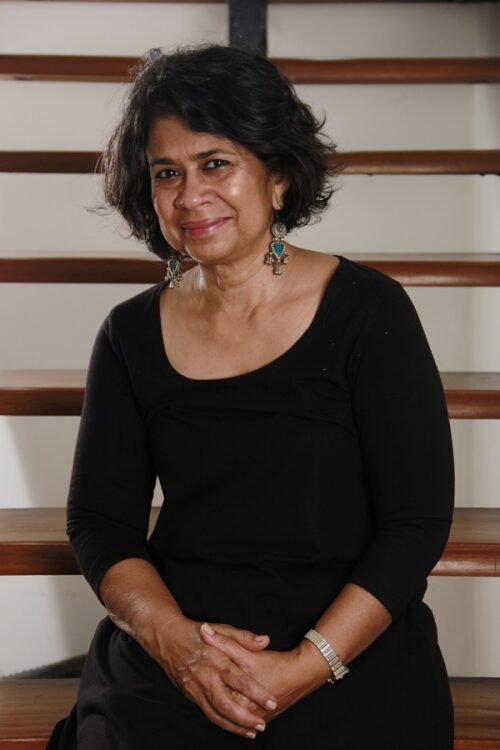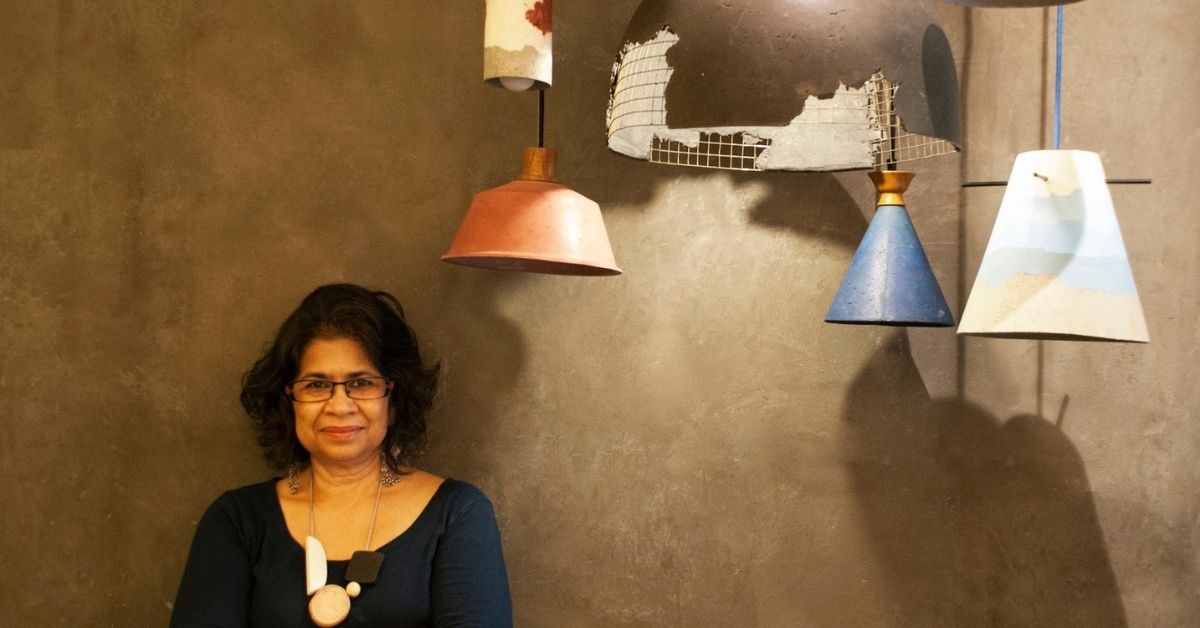When Jenny Pinto decided to leave the film industry in the 90’s, it was a radical move in more ways than one. The exit meant bidding adieu to the excitement of a fast paced life as an ad filmmaker, and welcoming the ups and downs of revolutionising an industry that was, back then, still untapped.
“I grew up in Mumbai and started my work life there. Just before liberalisation, it was a very exciting time to be in advertising,” she tells The Better India.
But on the brink of motherhood, she had started questioning consumerism and its impact on the environment. “I had started thinking about how I would like to bring my child up and what kind of a world she would grow up in,” she notes. It was time to move to greener living, even if she wasn’t yet sure of how she would do it.
Little would one have suspected that the birth of Jenny’s new life and career would go on to become a pioneering force in India’s sustainable paper and lighting industry. Today, her homegrown brand Oorjaa delivers products ranging from sophisticated lighting to crafty home accessories — all sourced from recycled waste.

For and from the environment
Jenny calls her tryst with paper-making an accidental discovery.
“In my mid-30s, I left Mumbai to resettle in Bengaluru and see what I could do to explore the environment from a more behavioural perspective. I was learning pottery there when I chanced upon a lec-dem (lecture-demonstration) on handmade paper,” she says.
One thing led to another, and by 1998, her interest had piqued enough to open a small studio, one of the first in India, to perfect the art of papermaking through trial and error.
As per the 2011 census, the use of waste materials in making green paper still recovers only 27% of waste paper and 22% of agricultural waste. A decade before that, these numbers were only grimmer.
It was against this backdrop that Jenny decided to learn how to make recycled paper from agricultural waste for a cleaner society.
“No one in India was making paper on a small scale this way, that is, chemical-free, from banana fibre, and translucent enough for lighting. But I found many such ventures in the United States,” she adds. In 2000, she spent a few months in Portland, working with paper made from natural fibres and lighting with Helen Hiebert.
Jenny believes that it is not difficult to make paper, but how one makes it green is what requires special attention.
“Paper is made from plant cellulose, so the material itself is natural. The source of the material and the process of extraction and production are the variables in this case,” she says, adding that the process involves cooking the fibre in water and additives and lofting the pulp on moulds.
Knowing the operation to be water-intensive, she set up a rainwater harvesting and water recycling unit so that all water from paper-making could be recycled and used in the garden. “I always use less toxic additives in the making. For example, the fibres are cooked in washing soda instead of caustic soda,” she says. This way, the paper can be recycled and safely composted after use.
A woman with a new trend
While she mastered the tricky process, upscaling it posed its own challenges.
Starting out small, Jenny had to convince machine manufacturers to deliver small-sized equipment. A novel technique meant a dearth of skilled people to build a team. She also had to find suppliers of agri-waste like banana fibre.
“I found a few manufacturers whom I could convince to make a small beater and press for my production. Finding banana fibre, my main raw material, also took time but I found it being extracted for the craft industry,” she reveals.
Convincing people to trust paper as a strong enough material for interior decoration was a tough nut to crack in itself. But to tackle this, she optimised on ground exhibitions to interact with her audience about the concept.
“There was also a growing band of architects who were exposed to international designers like Isamu Noguchi and Ingo Maurer, who had already used paper in lighting brilliantly, so one learnt to negotiate,” she says.
For production, Jenny discovered potential close to home. Rural artisans settled in Bengaluru from the east were noticed for their deftness with handicrafts. They were quick learners and enjoyed working with natural materials. “These people found us in search of work, and went on to stay with us for years,” she says.
After having personally trained them, Jenny today has about 50 men and women employed under her guidance.
Oorjaa
In 2018, her products metamorphosed into a full-fledged homegrown brand called Oorjaa. Jenny’s work as a lighting designer focussed on sustainable materials met the entrepreneurial knack of Radeesh Shetty, who provided funding for expansion.
“We included raw materials like faux cement which is made from quarry waste and cork which is fabricated from waste industrial cork. Our newest material is lantana camara, which is now considered a major threat to forests and wildlife in central and south India,” she reveals.
Their aim remains to repurpose and recycle whatever can be repurposed and recycled. “We fashion faux cement into lamps, doorknobs and other decoration pieces after crushing it. Water is recycled wherever possible in the papermaking process. The woven papers are used to create different kinds of lamps. The leftover cork is repurposed to create coasters and other products,” she says.
Since when she started out, Jenny has seen people become more conscious about what is being made and how. “Now a lot more people are conscious about where they source their products from. At times, it’s a part of the tender for certain architectural projects as well and they give preference to locally manufactured products,” she reveals.
If you too would like to switch to sustainable lighting for your home, check out Oorjaa’s products here.
Edited by Divya Sethu
All images by Oorjaa
If you found our stories insightful, informative, or even just enjoyable, we invite you to consider making a voluntary payment to support the work we do at The Better India. Your contribution helps us continue producing quality content that educates, inspires, and drives positive change.
Choose one of the payment options below for your contribution-
By paying for the stories you value, you directly contribute to sustaining our efforts focused on making a difference in the world. Together, let's ensure that impactful stories continue to be told and shared, enriching lives and communities alike.
Thank you for your support. Here are some frequently asked questions you might find helpful to know why you are contributing?

